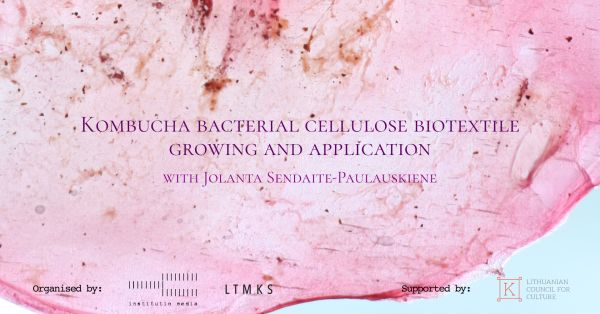Kombucha bacterial cellulose biotextile growing and application
Tutorial: Kombucha bacterial cellulose biotextile growing and application
With Jolanta Sendaitė-Paulauskienė
This tutorial invites humans to explore the connection with the other life forms through bio-fabric – bacterial cellulose that grows during the natural fermentation process of a kombucha drink. The tutorial looks into the properties of this material and possible future uses, as well as reflects on the symbolic meaning of biofabrics grown in the laboratory, human relationship with them, and connection to nature.
Kombucha is a fermented tea drink that has long been valued for its health-promoting probiotics. Over the past few decades, kombucha has enjoyed a renaissance and become extremely popular, not only because of its health benefits, but also the by-product (which is usually thrown away), the bacterial cellulose film that grows during this fermentation and can be used as a sustainable material.
In her creative practice, Jolanta Sendaitė-Paulauskienė relies on the creative principles of processual art, that emphasize not the final product (artwork), but the thinking itself, processuality. Using natural self-changing materials: bacteria, fungi, plant root systems, natural dyeing, she rethinks her relationship with materials. In her creative process the artist explores the phenomenon of the emergence of life, so it is important for her to leave space for growth and unpredictability, to allow the life forms to change and evolve.
Workshop: Kombucha bacterial cellulose biotextile growing and application
With Jolanta Sendaite-Paulauskiene
Time of the event: 24th of September, 12.00.
Venue: SODAS 2123 Alt Lab (Vitebsko str. 23, 2nd floor)
This workshop invites you to explore our connection with “the other” life forms through bio-fabric – bacterial cellulose that grows during the natural fermentation process of a kombucha drink.
During this workshop we will learn how the growth of this material takes place, how to prepare the right medium for it and will try handling the material for ourselves. The artist Jolanta Sendaitė-Paulauskienė will also present her experiments conducted during the study of “living” fabrics revealing the most important aspects related to this material.
We will not only familiarize ourselves with the practical aspects of “living” fabric, look into the properties of this material and possible future uses, but also reflect on the symbolic meaning of biofabrics grown in the laboratory, our relationship with them, and connection to nature.
Kombucha is a fermented tea drink that has long been valued for its health-promoting probiotics. Over the past few decades, kombucha has enjoyed a renaissance and become extremely popular, not only because of its health benefits, but also the by-product (which is usually thrown away), the bacterial cellulose film that grows during this fermentation and can be used as a sustainable material.
We kindly ask you to register by writing to: o-o@o-o.lt
Supported by: Lithuanian Council for Culture. Organised by: Institutio media in collaboration with Lithuanian Interdisciplinary Artists’ Union
About the artist
In her creative practice, Jolanta Sendaitė-Paulauskienė relies on the creative principles of processual art, that emphasize not the final product (artwork), but the thinking itself, processuality. Using natural self-changing materials: bacteria, fungi, plant root systems, natural dyeing, she rethinks her relationship with materials. In her creative process the artist explores the phenomenon of the emergence of life, so it is important for her to leave space for growth and unpredictability, to allow the life forms to change and evolve.
By growing biofabric/clothing, the creator aims to promote intuitive cognition through sensory experiences. And clothing is considered not only as a cultural phenomenon related to artifacts, but also as a physiological phenomenon determined by human development, which includes fluids, body tissues, microorganisms and the processes accompanying them. She explores the use of biofabric for clothing as the skin of the “other”, where the “other” is not only a subject, but also a different being, a different understanding, a different type of connection with the life forms that surround us. This is both sympoetics (D. Haraway’s term meaning “being in the world together”) and poetry.
